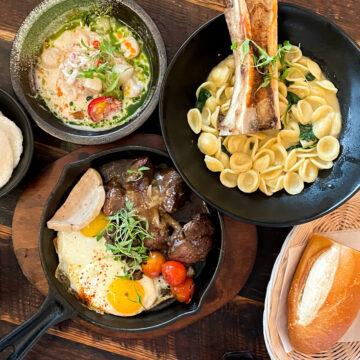If you're looking to get in shape, you've probably heard the term "macros" thrown around. But what exactly are macros, and how do you optimize your macros for cutting and eating healthy?
Whether your fitness goal is weight loss or building lean muscle mass, understanding macronutrients, or "macros," is an essential first step in achieving your goals. In this article, we'll break down the basics of macros and why they're important for healthy eating.

💭 What are Macros?
Macros are the three main macronutrients that make up the calories in the foods we eat - carbohydrates, proteins, and fats. Each macronutrient has a specific role in our bodies and the amount of each we consume affects our body composition, energy levels, and overall health.
They are essential in providing our bodies with energy and maintaining various bodily processes, such as muscle growth and repair, hormone regulation, and cell growth and maintenance.
While most foods consist of a variety of different types of macros, some foods consist of more of one type of macro than others. Here are examples of common cooking ingredients for each macro type:
Protein

- Examples – Chickens, eggs, shrimp, beef
- Why we need it – Macro that helps you build, maintain, and repair your muscles and bone. Also makes you feel the most full. Learn more science-backed benefits of eating enough protein.
- Calories per gram – 4
Fats

- Examples – Avocados, Heavy Cream, Oil, Butter
- Why we need it – The human body requires fat for a number of essential functions, including growth, energy, and protection of our organs, and that 25%-30% of our calories consumed should be from fat in a study by the U.S. Department of agriculture.
- Calories per gram – 9
Carbs

- Examples – Rice, Noodles, Fruits, Vegetables
- Why we need it – Carbs provide the body with glucose, which is used to power bodily functions and give us the energy for physical activities, according to Harvard School of Public Health.
- Calories per gram – 4
🍎 Why are Macros Important for Healthy Eating?
Traditional weight loss knowledge often touts the saying “calories in calories out”. Get a calorie surplus to build muscle, deficit to lose weight. While this is partially true, there is a second very crucial part to this equation, and that is understanding your macros for cutting.
Calories – Optimizing for this help determine what you weigh
Macros – Optimizing this help determine how you feel and how you look
For most people, macros for cutting means eating enough protein and eating portioned amounts of fat and carbs.
If you currently aren’t tracking how much protein you’re eating, you’re most likely not eating enough of it.
The reality is, whether your goal is to lose body fat or build muscle, eating ample protein is an essential part of the equation because:
- Protein makes you feel more full compared to fats and carbs, which are easy to overeat since they are not as satiating. Protein has gherlin, which is a hormone that helps suppress hunger. Eating enough protein is essential for feeling satiated and to power muscle growth.
- Protein powers essential healing and muscle building processes. Even if your goal is to lose weight, if you restrict calories without eating protein, its highly unlikely you will achieve a toned look that I would assume you are going after
- You will get higher ROI from your workouts. It doesn’t matter how much you lift at the gym or work out if you are not fueling your body with protein to aid in muscle synthesis.
That's not to say you should eat exclusively protein. If you're consuming too much protein and not enough carbohydrates, you may experience fatigue and muscle loss.
On the other hand, if you're consuming too many carbohydrates and not enough protein, for example, you may struggle to see results or even gain weight. The key is to keep a healthy balance.
Note: Consult with your healthcare provider before making dietary changes.
⚖️ Balanced Macro Diet
While protein is important, it's crucial to not cut out other macros for a well-balanced diet. For example, a popular trend I see people do is “cut carbs” in an effort to lose weight. Carbs often get a bad rap in the diet world because a lot of traditionally “unhealthy” foods, such as pizza or pasta, are predominantly made of carbs.
The reality is the reason they are “unhealthy” is due to a poor macronutrient balance and a lack of portion control of higher-calorie ingredients that ends up making the dish an excessive amount of calories. Carbs are an essential part of our diet and attempting to cut them out will likely lead to you feeling weak and fatigued.
So how do you consume carbs without blowing your calorie budget?
The key is portion control. Most of the recipes on my site will often use 1 serving or rice, noodles, or pasta, which is typically about 150-200 calories. This is a good serving size for my height and weight (5’4 female around 125 with an active lifestyle). I find that to be a good amount to power my workouts without excessive calorie consumption.
You can check out some healthy rice and healthy noodle recipes on my site.
To achieve your fitness goals, it's crucial to find the right balance of macros for cutting keep you satiated and energized. This will help you maintain lean muscle mass while reducing body fat, which is key to a successful cutting phase.
If you are a fan of Asian cuisine, I've create a collection of macro-friendly recipes for my favorite Asian cuisines here:
🧮 Macro Calculator and Food Scale
The easiest way to track your macro intake is to use a macro calculator or food scale. A macro calculator takes into account your activity level, current weight, and fitness goals to determine your total daily energy expenditure, or TDEE, and the amount of daily calories you need to consume to achieve your goals. From there, you can determine the best macro split for your needs.
It's important to note that macro ratios and total calorie intake can vary depending on individual needs and personal preference.
A good rule of thumb is to aim for at least 1 gram of protein per pound of body weight, and to consume adequate, but not large amounts, of carbohydrates and fats. To calculate your macros, you'll need to consider your daily caloric intake and your body's specific needs.
There are many online calculators and apps that can help you determine your ideal macro for cutting based on your age, weight, height, and activity levels. Here are a couple options:
Once you have your macro ratios, you'll need to track your food intake and make sure you're consuming the right amounts of each macronutrient. This can be done by using a food scale to measure portion sizes, reading food labels, or using a food tracking app.
💡Tips for Staying on Track with Macros
Staying on track with your macros can be challenging, but with the right mindset and preparation, it can be done. Here are some tips to help you stay on track:
- Plan ahead: Plan your meals and snacks for the week to ensure you're always prepared and have the right foods on hand.
- Be flexible: Don't be too rigid with your macro ratios. It's okay to have a cheat meal or a day off, as long as you get back on track the next day.
- Track What You Eat: The best way to ensure you're making progress is tracking your macros and calories! My Fitness Pal is a popular app that many people use to track their calorie and macro intake daily.
Note: The annual My Fitness Pal membership has a bar-code scanning feature that automatically populates nutrition info for foods you eat! You can use my link to get 10% off an annual membership.
- Get support: Join a fitness or nutrition group to stay motivated and on track with your goals.
- Online Coaching: Having a in-person or online coach will help keep you accountable and give you guidance throughout the process.
I highly recommend Noom, which gives you a personalized weight loss plan. This is one of my favorite apps to use because it gives you the guidance and accountability that hiring a personal trainer gives you at a fraction of the cost.
💡FAQs
As long as you are eating enough protein and eating at an appropriate calorie deficit, there is no significant difference in fat loss between a low fat high carb diet vs. a high fat low carb diet according to this study.
It will definitely feel like a lot in the beginning, but once you get into the groove of it, it will feel second nature! Give yourself some time and practice to track your food and portion correctly and you'll be a pro in no time.
You're in luck - the recipes on my site are all specially designed to be low calorie and macro friendly. Just pick what you're craving and follow the recipe and portion amounts to make a healthy and delicious meal!
Conclusion
Macros are an essential aspect of cutting and healthy eating, and understanding and implementing them can be the key to achieving your fitness goals. By finding the right balance of macronutrients, tracking your food intake, and staying on track with your goals, you'll be on your way to a healthier, happier you.






Leave a Reply